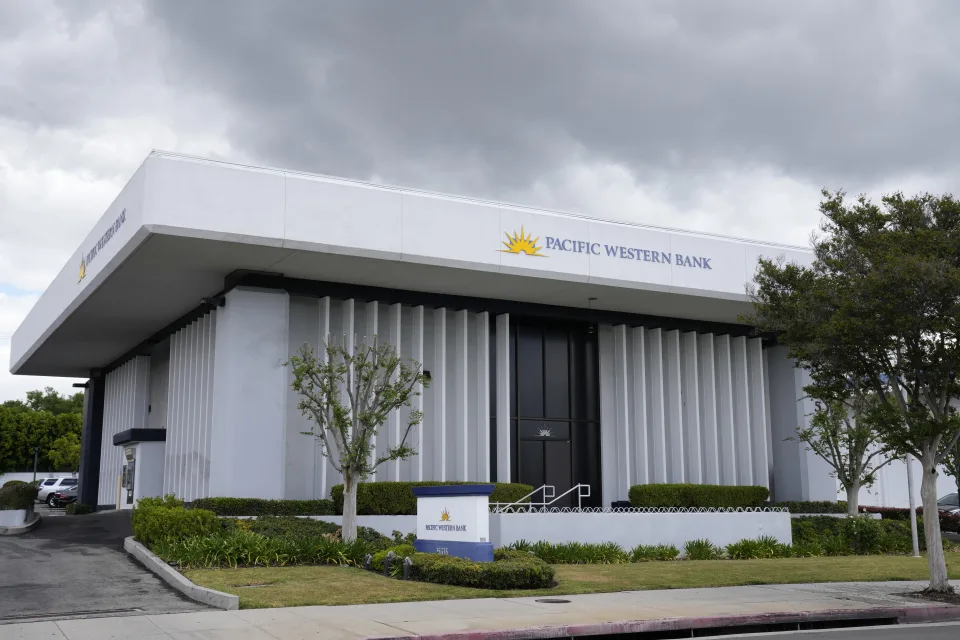PacWest (PACW) agreed to combine with smaller rival Banc of California (BANC), an all-stock deal that would end the independence of a regional lender that came under intense scrutiny following the downfall of Silicon Valley Bank.
The stock of Beverly Hills-based PacWest fell 27% Tuesday after news of the deal was reported by The Wall Street Journal, and the stock of Santa Ana-based Banc of California rose 11%.
Private equity groups Warburg Pincus and Centerview helped arrange $400 million in new equity from investors as part of the deal and would own roughly 20% of the combined bank. The pact is expected to close in late 2023 or early 2024, if it receives approvals from shareholders and regulators.
The union would create a $36 billion lender headquartered in Los Angeles under the Banc of California name, with more than 70 branches in California. It will be run by Banc of California CEO Jared Wolff and focus primarily on community banking in California markets.
Both banks serve wealthier customers in California, and PacWest is the far bigger lender when measured by assets. It was the nation’s 49th-largest bank as of March 31 by that measure, while Banc of California was the 135th largest.
But PacWest’s market value was just slightly higher at Tuesday’s close, $924 million as compared to Banc of California’s $842 million.
That is a reflection of PacWest’s many challenges this year as it worked to reassure depositors and investors about its liquidity and strength. Its stock is now down roughly 66% year to date.
Many regional banks stocks turned lower Tuesday on the news of the PacWest sale, offering a new reminder of the industry’s vulnerabilities.
The seizures of Silicon Valley Bank, Signature Bank, and First Republic in the spring triggered outflows at PacWest and scores of other regional banks, creating panic across the financial system.
Those deposit outflows eventually eased at many banks during the second quarter, and investors responded by pushing stocks higher.
The KBW Nasdaq Regional Bank Index (^KRX), which tracks the performance of the smaller banks, rose 7.3% last week, its best weekly performance in more than a year.
But regional banks still face numerous challenges. Most attracted more deposits during the quarter by paying a lot more for them, cutting into a key measure of profitability. Many also revised down estimates of future revenue or profits.
PacWest, like many regional banks, spent much of the second quarter shrinking its balance sheet as it tried to keep its depositors.
“We’re going to make sure that we look to avoid the concentration risks that I think all banks experienced over the last several years,” Banc of California CEO Jared Wolff told analysts on a Tuesday call.
In the first week of May, PacWest disclosed it was exploring “strategic asset sales” to improve its supply of cash on hand to meet potential depositor withdrawals. This included a $2.7 billion sale of its lender finance loan portfolio.
Last month PacWest also sold a $3.5 billion portfolio of consumer loans, mortgages, and other assets to Ares Management.
On Tuesday it reported that it lost another $196 million in the first quarter, and its net interest income also shrank as its funding costs rose. Net interest income measures the difference between what banks earn on their loans and pay for their deposits.
But its deposits were essentially flat, which was better than analysts expected. Its stock rose more than 30% in after-hours trading.
Banc of California has fared much better during the upheaval, down 8% year to date and up 29% since May 11. Its deposit outflows in the first quarter were much smaller than at PacWest.
It said Tuesday that its deposits dropped 1.1% in the second quarter, and its net income dropped 12% from the prior quarter.
Its stock was up more than 11% in after-hours trading.
Banc of California traces its origins to 1941, when it began as the credit union for Rohr Aircraft.
It became the Pacific Trust Federal Credit Union in 1995, changed its charter to a federal savings bank, and morphed into First PacTrust Bancorp Inc when it sold stock to the public in 2002.
A decade ago it changed its name to Banc of California. It currently has 28 full-service bank branches in California extending from San Diego to Santa Barbara.

